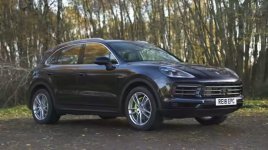tesla 1
Member
The 2019 Porsche Cayenne is a luxury midsize SUV that blends Porsche's sports car heritage with the practicality of an SUV. It is known for its excellent driving dynamics, luxurious interior, and wide array of tech features. Let’s dive into the key aspects:
1. Price
Starting Price: Around $66,000 (USD) for the base Cayenne model when new.
Higher Trims: Can go up to $125,000+ for the Cayenne Turbo or more for highly customized configurations.
2. Engine Options
The 2019 Cayenne comes with multiple engine choices, all paired with an 8-speed automatic transmission and all-wheel drive (AWD):
Base Cayenne: 3.0L V6 turbocharged engine
Power: 335 horsepower
Torque: 332 lb-ft
0-60 mph: 5.9 seconds
Top Speed: 152 mph
Cayenne S: 2.9L V6 twin-turbocharged engine
Power: 434 horsepower
Torque: 405 lb-ft
0-60 mph: 4.9 seconds
Top Speed: 164 mph
Cayenne Turbo: 4.0L V8 twin-turbocharged engine
Power: 541 horsepower
Torque: 567 lb-ft
0-60 mph: 3.7 seconds
Top Speed: 177 mph
3. Range and Fuel Economy
Base Cayenne:
Fuel Economy: 19 MPG city / 23 MPG highway.
Range: With a fuel tank capacity of 23.7 gallons, the Cayenne can achieve a range of approximately 450-500 miles on a full tank, depending on driving conditions.
Cayenne Turbo:
Fuel Economy: 14 MPG city / 21 MPG highway.
Range: Similar to the base model but with lower fuel efficiency, so the range is around 400 miles.
4. Size
Length: 193.7 inches (4,920 mm)
Width: 78.1 inches (1,983 mm)
Height: 66.8 inches (1,696 mm)
Wheelbase: 114 inches (2,895 mm)
Trunk Space:
27.2 cubic feet (770 liters) with the seats up.
60.3 cubic feet (1,710 liters) with the rear seats folded down.

5. Performance and Driving Dynamics
The 2019 Porsche Cayenne is highly regarded for its performance, handling, and driving dynamics. Despite its size, it offers a sporty driving experience similar to Porsche’s sports cars.
Handling: It features active air suspension, Porsche Active Suspension Management (PASM), and Porsche Dynamic Chassis Control (PDCC) on higher trims for agile cornering and stability.
Braking: Carbon-ceramic brakes are optional for high-performance trims like the Cayenne Turbo.
6. Interior and Features
The Cayenne’s cabin is luxurious and well-crafted, with premium materials and advanced technology.
Infotainment: 12.3-inch touchscreen with Porsche Communication Management (PCM), Apple CarPlay (but no Android Auto), navigation, and premium sound systems like the Burmester 3D Surround Sound System.
Comfort: Heated and ventilated front seats, dual-zone or quad-zone climate control, and optional leather upholstery.
Driver Assistance: Adaptive cruise control, lane-keeping assist, and automatic emergency braking.
7. Typical Defects and Issues
As a luxury SUV, the Cayenne has a relatively strong reliability record, but a few issues have been noted:
Electrical Issues: Some owners report problems with the infotainment system and connectivity features like Apple CarPlay.
Transmission/Drivetrain: Rare reports of issues with the 8-speed automatic transmission shifting smoothly, but these are not widespread.
Suspension: Air suspension systems in luxury vehicles can sometimes be prone to failures after extended use, leading to costly repairs.
Brakes: Wear and tear on the brake system can be faster due to the vehicle’s weight, especially for high-performance models.
8. Annual Maintenance Costs
Maintenance costs for the Porsche Cayenne are higher than for mainstream SUVs due to its luxury status and high-performance components.
Estimated Annual Cost: Around $1,200 to $1,500 annually, depending on the specific model and driving conditions.
Regular services (oil changes, tire rotations, etc.) are more expensive due to Porsche's premium parts.
Brake pad and rotor replacements can be costly, particularly for the higher-performance Turbo model.
Long-term maintenance costs can rise with air suspension and other high-tech features as the vehicle ages.
Conclusion
The 2019 Porsche Cayenne is a top-tier luxury SUV with outstanding performance, handling, and a luxurious interior. It’s ideal for those seeking a blend of SUV practicality with sports car driving dynamics. However, potential buyers should consider the higher purchase price, premium maintenance costs, and occasional issues with the electronics or suspension.
This model competes well against other luxury SUVs like the BMW X5, Mercedes-Benz GLE, and Audi Q7, offering a more performance-oriented experience than most.
Youtube
1. Price
Starting Price: Around $66,000 (USD) for the base Cayenne model when new.
Higher Trims: Can go up to $125,000+ for the Cayenne Turbo or more for highly customized configurations.
2. Engine Options
The 2019 Cayenne comes with multiple engine choices, all paired with an 8-speed automatic transmission and all-wheel drive (AWD):
Base Cayenne: 3.0L V6 turbocharged engine
Power: 335 horsepower
Torque: 332 lb-ft
0-60 mph: 5.9 seconds
Top Speed: 152 mph
Cayenne S: 2.9L V6 twin-turbocharged engine
Power: 434 horsepower
Torque: 405 lb-ft
0-60 mph: 4.9 seconds
Top Speed: 164 mph
Cayenne Turbo: 4.0L V8 twin-turbocharged engine
Power: 541 horsepower
Torque: 567 lb-ft
0-60 mph: 3.7 seconds
Top Speed: 177 mph
3. Range and Fuel Economy
Base Cayenne:
Fuel Economy: 19 MPG city / 23 MPG highway.
Range: With a fuel tank capacity of 23.7 gallons, the Cayenne can achieve a range of approximately 450-500 miles on a full tank, depending on driving conditions.
Cayenne Turbo:
Fuel Economy: 14 MPG city / 21 MPG highway.
Range: Similar to the base model but with lower fuel efficiency, so the range is around 400 miles.
4. Size
Length: 193.7 inches (4,920 mm)
Width: 78.1 inches (1,983 mm)
Height: 66.8 inches (1,696 mm)
Wheelbase: 114 inches (2,895 mm)
Trunk Space:
27.2 cubic feet (770 liters) with the seats up.
60.3 cubic feet (1,710 liters) with the rear seats folded down.

5. Performance and Driving Dynamics
The 2019 Porsche Cayenne is highly regarded for its performance, handling, and driving dynamics. Despite its size, it offers a sporty driving experience similar to Porsche’s sports cars.
Handling: It features active air suspension, Porsche Active Suspension Management (PASM), and Porsche Dynamic Chassis Control (PDCC) on higher trims for agile cornering and stability.
Braking: Carbon-ceramic brakes are optional for high-performance trims like the Cayenne Turbo.
6. Interior and Features
The Cayenne’s cabin is luxurious and well-crafted, with premium materials and advanced technology.
Infotainment: 12.3-inch touchscreen with Porsche Communication Management (PCM), Apple CarPlay (but no Android Auto), navigation, and premium sound systems like the Burmester 3D Surround Sound System.
Comfort: Heated and ventilated front seats, dual-zone or quad-zone climate control, and optional leather upholstery.
Driver Assistance: Adaptive cruise control, lane-keeping assist, and automatic emergency braking.
7. Typical Defects and Issues
As a luxury SUV, the Cayenne has a relatively strong reliability record, but a few issues have been noted:
Electrical Issues: Some owners report problems with the infotainment system and connectivity features like Apple CarPlay.
Transmission/Drivetrain: Rare reports of issues with the 8-speed automatic transmission shifting smoothly, but these are not widespread.
Suspension: Air suspension systems in luxury vehicles can sometimes be prone to failures after extended use, leading to costly repairs.
Brakes: Wear and tear on the brake system can be faster due to the vehicle’s weight, especially for high-performance models.
8. Annual Maintenance Costs
Maintenance costs for the Porsche Cayenne are higher than for mainstream SUVs due to its luxury status and high-performance components.
Estimated Annual Cost: Around $1,200 to $1,500 annually, depending on the specific model and driving conditions.
Regular services (oil changes, tire rotations, etc.) are more expensive due to Porsche's premium parts.
Brake pad and rotor replacements can be costly, particularly for the higher-performance Turbo model.
Long-term maintenance costs can rise with air suspension and other high-tech features as the vehicle ages.
Conclusion
The 2019 Porsche Cayenne is a top-tier luxury SUV with outstanding performance, handling, and a luxurious interior. It’s ideal for those seeking a blend of SUV practicality with sports car driving dynamics. However, potential buyers should consider the higher purchase price, premium maintenance costs, and occasional issues with the electronics or suspension.
This model competes well against other luxury SUVs like the BMW X5, Mercedes-Benz GLE, and Audi Q7, offering a more performance-oriented experience than most.
Youtube
